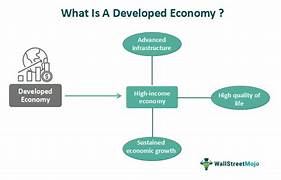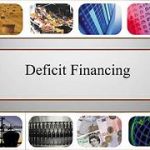Comparative Study on Developed and Developing Economies
Introduction
The global economy consists of a diverse range of nations, each at different stages of development. Broadly, economies are classified into developed and developing categories based on factors such as GDP per capita, industrialization, infrastructure, and standard of living. Understanding the key differences between these two economic categories provides insight into global trade, investment strategies, and policy-making. This article explores the characteristics, challenges, and opportunities of developed and developing economies while analyzing their interactions in the global economic system.
1. Characteristics of Developed Economies
Developed economies, also known as advanced economies, exhibit specific features that set them apart:
- High GDP per Capita: Developed nations have significantly higher income levels and purchasing power.
- Industrialization and Technological Advancement: These economies are highly industrialized and focus on innovation, automation, and digital transformation.
- Strong Institutions and Governance: Developed countries have well-established legal systems, transparent governance, and strong regulatory frameworks.
- Low Population Growth Rates: Birth rates tend to be lower due to better education and healthcare systems.
- Diverse Economic Sectors: The service sector, including finance, information technology, and healthcare, contributes significantly to GDP.
Examples of developed economies include the United States, Germany, Japan, Canada, and Australia.
2. Characteristics of Developing Economies
Developing economies, also referred to as emerging or underdeveloped economies, display different structural attributes:
- Lower GDP per Capita: Income levels are significantly lower compared to developed nations, leading to reduced purchasing power.
- Agriculture-Based Economy: Many developing nations rely heavily on agriculture and resource extraction.
- Weak Infrastructure: Limited access to quality roads, electricity, and digital infrastructure affects economic growth.
- High Population Growth: Many developing nations experience rapid population growth, straining resources and services.
- Informal Employment: A significant portion of the labor force works in informal, unregulated sectors.
Examples of developing economies include India, Nigeria, Brazil, Indonesia, and Bangladesh.
3. Economic Growth and Development: Key Differences
- Growth Rate: Developing economies often experience higher growth rates due to rapid industrialization and infrastructure expansion, whereas developed economies grow at a steady but slower pace.
- Wealth Distribution: Income inequality is often more pronounced in developing economies, whereas developed economies implement social welfare programs to mitigate disparities.
- Innovation and Technology: Developed economies invest heavily in research and development, while developing economies may rely on technology transfer and foreign direct investment (FDI).
4. Challenges Faced by Developing Economies
Developing economies encounter numerous obstacles that hinder their progress:
- Poverty and Unemployment: High poverty rates and lack of formal employment opportunities reduce economic potential.
- Political Instability and Corruption: Weak governance structures and corruption deter foreign investment and economic stability.
- Debt Burden: Many developing nations struggle with high external debt, limiting their ability to invest in infrastructure and education.
- Climate Change and Environmental Concerns: Rapid industrialization often leads to environmental degradation, affecting long-term sustainability.
5. Challenges Faced by Developed Economies
Developed economies also face economic and social challenges:
- Aging Population: Declining birth rates lead to workforce shortages and increased healthcare costs.
- Economic Stagnation: Low economic growth rates can lead to stagnant wages and lower productivity gains.
- Rising Inequality: Despite social programs, income and wealth disparities continue to pose policy challenges.
- Deindustrialization: The shift towards a service-based economy has led to job losses in traditional manufacturing sectors.
6. Global Interactions Between Developed and Developing Economies
The relationship between developed and developing economies plays a crucial role in global economic dynamics:
- Trade Partnerships: Developed nations often import raw materials from developing countries and export manufactured goods and services.
- Foreign Direct Investment (FDI): Multinational corporations from developed economies invest in developing nations, leading to technology transfer and job creation.
- International Aid and Development Programs: Developed nations provide financial aid and technical assistance to support economic development in poorer regions.
- Migration and Workforce Dynamics: Labor migration from developing to developed economies fills skill gaps but can lead to brain drain in the home countries.
7. Future Outlook and Strategies for Sustainable Growth
- Investment in Education and Skill Development: Developing economies must focus on improving human capital to enhance productivity and innovation.
- Strengthening Institutions and Governance: Transparency, legal reforms, and anti-corruption measures are crucial for long-term stability.
- Sustainable Industrialization: Encouraging eco-friendly industries and renewable energy investments will benefit both economic development and environmental sustainability.
- Enhancing Trade and Regional Cooperation: Developing nations can benefit from regional economic integration and trade agreements to boost economic resilience.
Conclusion
The comparative study of developed and developing economies highlights their distinct characteristics, challenges, and opportunities. While developed economies enjoy economic stability and technological advancement, they face aging populations and slow growth. Developing economies, on the other hand, have high growth potential but must overcome structural barriers such as poverty, weak governance, and infrastructure deficits. Through strategic policies, investment, and international cooperation, both developed and developing economies can achieve sustainable growth and contribute to a balanced global economic landscape.


